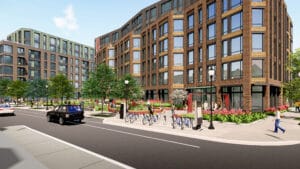
Allston Green is a $140-million, 250,000-square-foot complex featuring three buildings at 20 Linden St. in Allston scheduled for completion in 2024. Image courtesy of Prellwitz Chilinksi Assoc.
Millennial housing. Innovation units. Studio apartments. Compact living units. Whatever you call them, developments featuring tiny spaces are popping up again fueled by singles and couples looking for a place to rest their heads within city limits.
Compact units solve a problem Boston has wrestled with for decades: affordable housing that is attractive to young professionals and keeps Millennials from doubling up in triple-deckers best suited to working families. Housing the region’s growing population is a goal for mayors in the region’s most expensive and congested cities such as Somerville and Cambridge. Boston Mayor Marty Walsh has committed to building 69,000 new housing units by 2030 as part of the Housing a Changing City: Boston 2030 plan.
Small living spaces – studios and one-bedroom apartments ranging from 280 to 450 square feet – made a splash on the Boston development scene in 2013 when the first units hit the market and were quickly snapped up. By 2014 there were more than 350 units planned for the Seaport District, just as it was approaching “hottest neighborhood” status.
Pilot Program Offers Flexibility
These well-located developments provide affordable options in housing constrained neighborhoods like Allston-Brighton and the Seaport. The units are within walking distance to public transportation, restaurants and nightlife, making them attractive to younger renters.
The trend toward building smaller is also driven by the shortage of studio apartments. According to the city of Boston, two-thirds of the city’s population is comprised of singles and couples, while one-third of housing units are studios and one-bedroom apartments.

Margarita Kvacheva
In 2018, the city of Boston launched the compact living pilot program, giving developers the green light to build smaller units: 450 to 950 square feet in new projects of 10 units or more. The goals of the program include:
- Increase housing affordability through more units overall, including more inclusionary development policy (IDP) units and alleviating market pressure on family-style homes.
- Build community on both a building scale and a neighborhood scale by creating spaces that encourage people to connect outside their unit.
- Promote sustainable development creating less energy and less single-occupancy vehicle trips.
- Encourage creativity and innovation in how developers and designers meet the needs of residents.
Unlike micro-units, the development of compact living units has stringent requirements for parking, open space and community space and is monitored by the city of Boston.
Middle-Market Solution in Allston
Developed by LBC Boston, Allston Green is a $140 million, 250,000-square-foot complex featuring three buildings at 20 Linden St. in Allston on approximately 2 acres. The 350-unit project is slated to be completed in the spring of 2024 and is meant to provide a new product type that bridges the gap between luxury and affordable housing, creating a middle market solution.

Alex Matov
In addition to new housing, LBC Boston will create over 34,000 square feet of open space. Over 20,000 square feet of open space will be accessible to the public and will be used for community gatherings such as farmers’ markets, outdoor movie nights and exhibits. LBC Boston plans to invite local artists to paint murals and to create unique sitting cubes to be installed in the public parks.
Designed by Prellwitz Chilinksi Assoc. of Cambridge, Allston Green strategically places three buildings and two green spaces on the site. Variations in building planes and setbacks, a rich palette of exterior materials, and the playful use of color frame active, public ground floor uses that engage residents and neighbors alike. Proposed ground floor uses include a gallery, retail and artist coworking space, as well as the tower’s lobby and amenities.
Although compact living projects are new in multifamily development circles, renters are learning about the potential benefits: living in an efficiently designed, more affordable product in a community setting. Other benefits include lower utility bills and less maintenance. Better yet, paying the rent doesn’t require working the night shift.
Alex Matov is a principal owner and Margarita Kvacheva is a senior vice president at LBC Boston.




 |
| 
